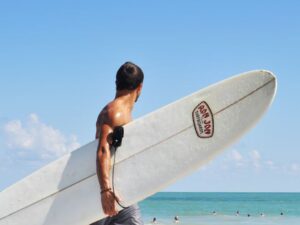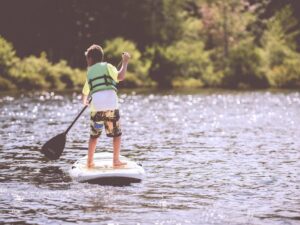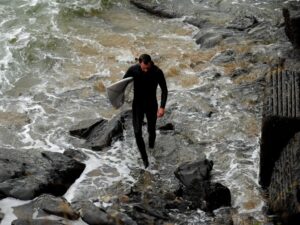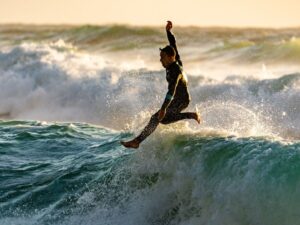Surfing is an intimidating sport. Oceans are big enough as it is, but when you factor in those massive waves, you’re somehow supposed to “ride,” one tends to stop and ask whether humans are supposed to do this or not.
That said, kudos to you for trying to be prepared and scouring the internet to find out what to expect during surfing.
I’ve been surfing for a few years, and transitioning from my beginner status took a while. If I had known things I now know, it would’ve taken me less than half the time to get better at surfing.
In general, surfing is hard for beginners as it’s a challenging and physically demanding sport that requires balance, coordination, timing, and the ability to read and interpret ocean conditions. However, with patience and practice, anyone can learn to surf.
Yes, ANYONE can learn to surf. And you can take that to the bank.
Developing proficiency in surfing necessitates good physical fitness, coordination, and balance. It’s best to start with the basics and work gradually to build competence and confidence.
Pro Tip: Be bold and ask questions. Seeking instruction from a reputable instructor and using proper equipment will make learning easier.
How long does it take to learn surfing?
Generally, beginners can take several weeks to a few months of consistent practice to learn the basic skills of surfing, such as paddling, standing up, and riding small waves. However, surfing is a complex and dynamic sport that requires consistent practice to hone your skills and technique.
While it’s possible to pick up the basics of surfing relatively quickly, becoming a proficient and confident surfer takes time, dedication, and patience. The time it takes to learn how to surf varies depending on several factors, including natural ability, physical fitness, experience with similar activities, and, most importantly, consistency.
Can surfing be self-taught?
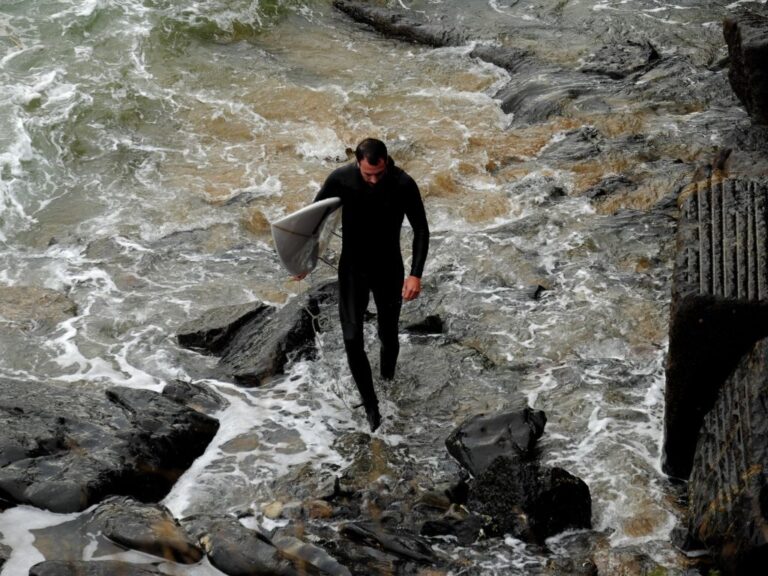
Surfing can be self-taught, but only to a certain extent. You can learn basic techniques and knowledge from online tutorials or by observing other surfers. However, taking lessons from a qualified instructor is generally recommended to ensure safety and maximize learning potential.
I know you’re confused. If it’s possible to understand the techniques, why would you need an instructor? There’s this saying, “practicing alone only embeds your errors.”
Learning how to surf on your own can pose some safety risks. There’s a lot to learn, and while you may be able to learn some, you can’t do them all alone. You may need adequate instructions on ocean awareness, paddling technique, and managing potential hazards like strong currents and unexpected changes in wave conditions.
These skills are crucial for surfing safely and responsibly; learning them from an experienced instructor can help ensure you stay safe in the water.
Read More: How to teach yourself to surf? How to learn without an instructor?
What skill is needed the most in surfing?
While several skills are important in surfing, good balance, flexibility, and instinct (ocean awareness) are the most crucial.
Good balance is essential for standing up and riding waves, and it requires a combination of core strength, strong arms and legs, and coordination.
Ocean awareness is critical for safe and effective surfing. Understanding how to read ocean conditions such as tides, currents, and wave patterns can help surfers avoid hazards and maximize their potential for catching waves.
And if we’re talking about skills, you must learn to stand on and turn the board. To stand up on the board, your knees should be bent, your body balanced, and your eyes forward, analyzing the wave, not looking down on your board.
Practice on the beach to learn how to stand properly to prepare for the movement. Additionally, get the hang of paddling, catching a wave, and balancing while standing during a wave to learn to turn and maneuver your board.
You can do so by applying pressure to the back of the board as you lean slightly with the carve. Your hips, head, and torso should remain upright while you use your lower body to steer the board.
What is the best age to learn to surf?
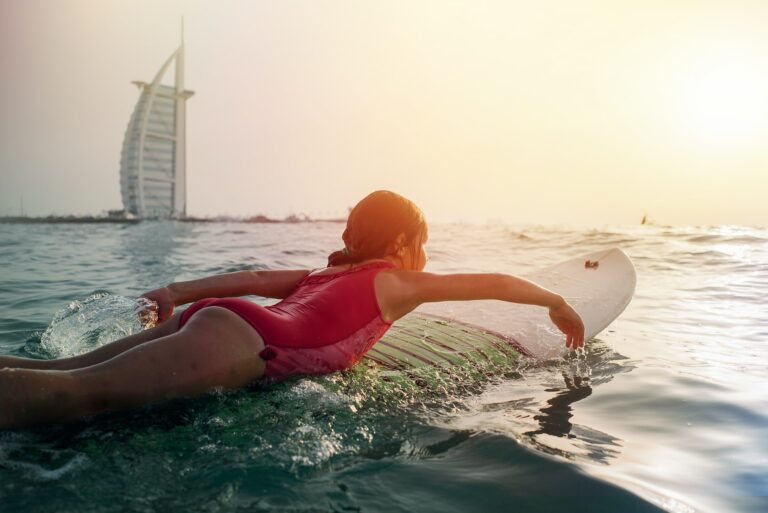
No specific age is considered the “best” to learn how to surf, as people of all ages can enjoy and excel in the sport. However, children should generally be at least six years old before starting formal surfing lessons.
For younger children, it can be helpful to develop foundational skills such as swimming and balance through activities like bodyboarding or playing in the shallow surf. This can help build confidence and comfort in the water before progressing to standing up on a surfboard.
Adults can start surfing at any age, and many people begin later in life and continue to enjoy the sport well into their golden years. However, it may take longer for older adults to develop the strength, flexibility, and balance needed for surfing.
Overall, the best age to learn surfing depends on individual factors such as physical abilities, prior experience in the water, and personal interests. With practice and dedication, anyone can learn to surf and experience the thrill of riding the waves regardless of age.
What is the hardest part of surfing?
For many people, the hardest part of surfing is simply getting up on the board and catching a wave. Balancing on a moving board while navigating the waves can be challenging, especially for beginners still learning the basics.
Many believe paddling is the hardest part of surfing, as it takes a lot of strength. Not to mention you gotta learn the skill to recognize which wave is worth paddling up.
I personally believe the hardest part in the entire learning curve of surfing is transitioning from riding whitewash dialing in your pop-up technique to confidently paddling into a lineup. And learning to effectively read the direction in which a wave is going to break, so you can paddle into it successfully.
Another difficult aspect is reading the ocean conditions and knowing when and where to catch a wave. Even experienced surfers need to be constantly aware of factors like wind direction, tides, and swell size, as they can all affect the quality and safety of the waves.
What not to do when surfing?
When surfing, there are a few things you’ll want to avoid to keep yourself and others safe in the water. Here are some key things not to do:
1. Don’t skip the basics: Even if you’re an experienced athlete or a natural in the water, it’s important to learn the basics of surfing. Skipping fundamentals can lead to frustration, injury, and a slower learning curve.
2. Don’t surf alone: Surfing can be dangerous, and having a buddy or a group of friends to surf with is not only more fun but also safer. Even experienced surfers can get into trouble in the water, and having someone nearby to help can make all the difference.
3. Don’t underestimate the conditions: Surfing conditions can change quickly and unexpectedly. Even if the waves look small and gentle, there may be strong currents or hidden hazards that can be dangerous.
4. Don’t ignore proper equipment: A suitable surfboard, wetsuit, leash, and wax, can make a big difference in your surfing experience. Don’t skimp on quality equipment, and make sure it’s properly maintained and fitted to your size and skill level. Another thing to avoid is ditching your board when falling off – try to hold onto it instead of letting it go loose in the water.
5. Don’t compare yourself to others: Surfing is a personal journey, and everyone learns at their own pace. Don’t compare yourself to other surfers, especially more experienced ones, and focus on your own progress and enjoyment in the sport.
6. Don’t be afraid to ask for help: There’s no shame in asking for help or advice from more experienced surfers or instructors. Take advantage of resources like surf schools, online tutorials, and local surf communities to improve your skills and knowledge.
7. Don’t surf under the influence: I know it’s obvious but don’t surf under the influence of drugs or alcohol, as it can impair judgment and reaction time, increasing the risk of accidents and injuries.
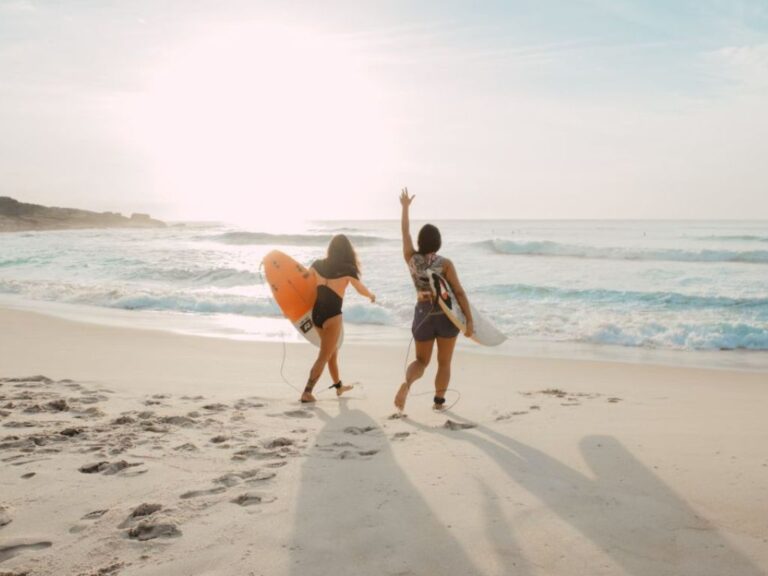
Where is the easiest place to learn to surf?
If you’re looking for an easy place to learn how to surf, several destinations worldwide are known for being beginner-friendly.
Surfing hubs like Waikiki Beach in Hawaii, Byron Bay in Australia, Taghazout in Morocco, Nosara in Costa Rica, and Bali in Indonesia are some of the easiest places to learn how to surf. This is due to the presence of several qualified surf instructors and beginner-friendly waves.
Waikiki Beach is a great option for beginners due to its gentle waves and warm water. Byron Bay also has a variety of surf breaks that cater to all skill levels, along with plenty of surf schools and instructors available to teach newbies.
Taghazout in Morocco has become a popular destination for surfers of all levels, with various surf schools and accommodations available. Meanwhile, Nosara’s Guiones Beach is a long, sandy stretch with consistent waves, perfect for those just starting.
Finally, Bali offers several beaches with smaller waves that are perfect for beginners while still offering the opportunity to experience some of the world’s best surf spots.
Ultimately, the best spot to learn to surf will depend on various factors, including the time of year, wave conditions, and availability of surf schools and instructors. Nonetheless, these beginner-friendly destinations are a great place to start!


